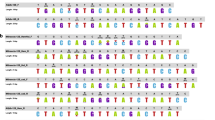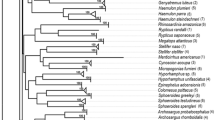Abstract
We examined the genetic identities of 49 individuals of four species of eels in the genus Anguilla Shaw, A. anguilla, A. japonica, A. reinhardti and A. rostrata, using the random(ly) amplified polymorphic DNA (RAPD)-PCR technique. We used 15 random decamer primers. Out of the 22 148 amplification products detected, 454 markers were evaluated using Nei's distance coefficient, two numerical methods (neighbor-joining, UPGMA), and phylogenetic analysis using parsimony (PAUP). Both numerical and parsimony methods were congruent and confirmed the specific status of all four examined Anguilla species. In all dendrograms, all individuals of each of the species clustered together within four closed groups with highly significant bootstrap values (between 97 and 100%). Additionally 1 to 18 species-specific monomorphic diagnostic fragments were detected in three of the species; none were detected in A. anguilla. Mean interspecific genetic distances ranged from 0.384 to 0.559, with the minimum between A. anguilla and A. rostrata and the maximum between A. anguilla and A. reinhardti. Individuals collected at one locality and belonging to a single species did not cluster together, and neither were any diagnostic monomorphic fragments found for individuals of single localities. This probably reflects a random dispersal of larvae in ocean currents before they reach coastal waters. Among all possible species pairs, only the two Atlantic species were consistently clustered in all dendrograms, with highly significant bootstrap values (100%). Additionally, we detected ten diagnostic markers for this pair of eel species. From RAPD data, we suggest a phylogram which was routed by the descending analysis method: A. reinhardti appears to have been the first species to diverge from a putative common ancestor of the four eel species. Later, A. japonica separated from the hypothetical ancestor of the Atlantic species, which then split recently into A. anguilla and A. rostrata. The close relationship of A. anguilla and A. rostrata is indicated by their low genetic distance (GD = 0.384) and a high degree of shared RAPD fragments (SF = 71.2%); this compares with the following means for all other species pairs: ( = 0.531, = 44.2%). The prerequisites for using RAPD data for the reconstruction of phylogenies are discussed.
Similar content being viewed by others
Author information
Authors and Affiliations
Additional information
Received: 2 September 1999 / Accepted: 8 May 2000
Rights and permissions
About this article
Cite this article
Lehmann, D., Hettwer, H. & Taraschewski, H. RAPD-PCR investigations of systematic relationships among four species of eels (Teleostei: Anguillidae), particularly Anguilla anguilla and A. rostrata . Marine Biology 137, 195–204 (2000). https://doi.org/10.1007/s002270000349
Issue Date:
DOI: https://doi.org/10.1007/s002270000349




